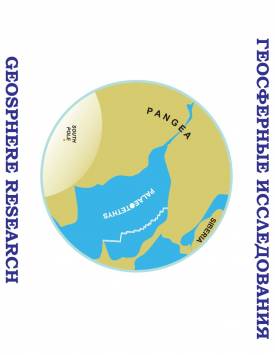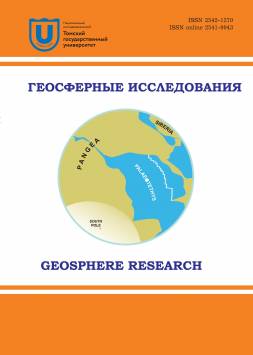Mapping the potential danger of forest fires using statistical methods, GIS and satellite images
Forest fires are one of the main natural disasters that cause huge damage to natural resources, threaten people's lives and the safety of important industrial facilities. (LP) In order to prevent and extinguish fires, it is extremely important to be able to identify places where critical conditions for a fire hazard develop and important facilities are located that are most at risk for environmental, physical or socio-economic reasons. Currently, researchers both in Russia and abroad often use remote sensing to study the mechanisms of forest fires in various ecosystems. The purpose of this study is to assess the territory of the Verkhoyansky ulus site according to the degree of risk of forest fires using statistical methods, GIS and DDZ. Based on archival data on forest fires in Yakutia for 2017-2021, satellite images from Landsat satellites for May, June, July, August 2017-2021, Terra (ASTER) 2013 after performing radiometric and atmospheric correction, the values of spectral indices and terrain parameters were calculated. As a result of the analysis of historical data on forest fires, a research site was selected to study the state of plant communities. This study presents an analysis of the impact of landscape and anthropogenic factors on forest fires using the Bayesian WOE evidence weight model, which consists of a statistical model of the spatial relationship between actual LP cases and the presence or absence of predictors that represent landscape conditions and anthropogenic influence. WOE models are built for binary classification, where the presence or absence of fires throughout the site is used to calculate the weight (evidence) of the importance of each category of predictive/explanatory factors (predictors). The main assumption of the WOE method is that future events (fire incidents) are more likely to occur in areas with conditions similar to those that contributed to past events. Geospatial data sets were processed and analyzed, and maps of potential fire hazard for the site were created, combining several thematic layers. The effectiveness of the model was evaluated using the ROC-AUC method, which showed that the WOE model classifies the territory quite well (accuracy up to 76 %) according to the level of fire hazard. Timely, adequate assessment of the danger of a forest fire and mapping of areas of potential fire danger are important and necessary to determine the scope of preventive fire-fighting measures and effective fire extinguishing actions. Contribution of the authors: the authors contributed equally to this article. The authors declare no conflicts of interests.
Keywords
satellite images,
forest fires,
mapping,
statistical methods,
GIS,
bayesian modeling of the weight of evidenceAuthors
| Struchkova Galina P. | Yakutsk Scientific Center, SB RAS, V.P. Larionov Institute of Physical and Technical Problems of the North, SB RAS | pandoramy8@list.ru |
| Kapitonova Tamara A. | Yakutsk Scientific Center, SB RAS, V.P. Larionov Institute of Physical and Technical Problems of the North, SB RAS | kapitonova@iptpn.ysn.ru |
| Krupnova Tatyana G. | South Ural State University | krupnovatg@susu.ru |
| Tikhonova Sardana A. | Yakutsk Scientific Center, SB RAS, V.P. Larionov Institute of Physical and Technical Problems of the North, SB RAS | sardankobeleva@gmail.com |
| Tarskaya Lina E. | Yakutsk Scientific Center, SB RAS, V.P. Larionov Institute of Physical and Technical Problems of the North, SB RAS | lina.tarskaya@mail.ru |
| Rakova Olga V. | South Ural State University | rakovaov@susu.ru |
Всего: 6
References
Белоусова Е.П., Латышева И.В., Латышев С.В., Лощенко К.А. и др. Природные факторы возникновения лесных пожаров на территории Иркутской области // Биосфера. 2016. № 4-8. С. 390-400.
Кузнецов Г.В., Барановский Н.В. Прогноз возникновения лесных пожаров и их экологических последствий. Новосибирск : СО РАН, 2009. 301 с.
Курганович К.А., Макаров В.П Использование вегетационных индексов NDVI для оценки влияния пожаров на динамику растительности Цасучейского бора // Вестник ЗабГУ. 2015. Т. 117, № 2. С. 27-36.
Латышева И.В., Вологжина С.Ж., Лощенко К.А. Циркуляционные факторы возникновения лесных пожаров на территории Сибири и Дальнего Востока летом 2019 и 2021 гг. // Известия Иркутского государственного университета. Серия «Науки о Земле». 2021. Т. 38. С. 54-70.
Нестеров В.Г., Гриценко М.В., Шабунина Т.А. Использование температуры точки росы при расчете показателя горимости леса // Метеорология и гидрология. 1968. № 9. C. 102-104.
Павличенко Е.А., Иванов В.В., Миськив С.И. Использование геоинформационных систем при анализе и прогнозе природных чрезвычайных ситуаций на примере мониторинга лесных пожаров // Технологии гражданской безопасности. 2004. № 4. С. 46-51.
Протопопова В.В., Габышева Л.П. Горимость лесов Верхоянского района (Северо-Восточная Якутия) // Успехи современного естествознания. 2017. № 5. C. 66-71.
Пушкин А.А., Сидельник Н.Я., Ковалевский С.В. Использование материалов космической съемки для оценки пожарной опасности в лесах // Труды БГТУ. 2015. № 1. С. 36-40.
Сидельник Н.Я., Пушкин А.А., Ковалевский С.В. Картирование поврежденных лесных насаждений и объектов лесохозяйственных мероприятий с использованием материалов космической съемки и ГИС // Труды БГТУ. 2018. Серия 1. № 1. С. 5-12.
Стручкова Г.П., Крупнова Т.Г., Тихонова С.А., Капитонова Т.А., Ракова О.В. Оценка опасности возникновения лесных пожаров с использованием спутниковой информации и ГИС // Вестник Воронежского государственного университета. География. Геоэкология. 2023. № 4. С. 34-44.
Bonham-Carter G.F. Geographic Information Systems for Geoscientists, Modeling with GIS. Oxford : Pergamon Press, 1994. 398 p.
Bovio G., Quaglino A., Nosenzo A. Individuazione di un indice di previsione per il pericolo // Monti e Boschi. 1984. V. 35, No. 4. P. 39-44.
Chowdhury Ehsan H., Hassan Quazi K Operational perspective of remote sensing-based forest fire danger forecasting systems / ISPRS Journal of Photogrammetry and Remote Sensing. 2015. V. 104. P. 224-236.
Dlamini M., Wisdom А. A Bayesian belief network analysis of factors influencing wildfire occurrence in Swaziland // Environmental Modelling & Software. 2010. V. 25, Iss. 2. P. 199-208. doi: 10.1016/j.envsoft.2009.08.002.
Hanley J.A., McNeil B.J. The meaning and use of the area under a receiver operating characteristic (ROC) curve // Radiology. 1982. V. 143 (1). P. 29-36.
Hernandez-Leal P.A., Arbelo M., Gonzalez-Calvo A. Fire risk assessment using satellite data // Advances in Space Research. 2006. V. 37, Is. 4. P. 741-746.
Hong Haoyuan, Jaafari Abolfazl, Zenner Eric K Predicting spatial patterns of wildfire susceptibility in the Huichang County, China: An integrated model to analysis of landscape indicators // Ecological Indicators. 2019. V. 101. P. 878-891. doi: 10.1016/j.ecolind.2019.01.056.
Huesca Margarita, Litago Javier, Merino-de-Miguel Silvia, Cicuendez-Lopez-Ocana Victor, Palacios-Orueta Alicia Modeling and forecasting MODIS-based Fire Potential Index on a pixel basis using time series models // International Journal of Applied Earth Observation and Geoinformation. 2014. V. 26. P. 363-376.
Jaafari A., Najafi A., Rezaeian J., Sattarian A., Ghajar I. Planning road networks in landslide-prone areas: a case study from the northern forests of Iran // Land Use Policy. 2015. V. 47. P. 198-208.
Jaafari A., Zenner K Eric, Thai Pham Binh Wildfire spatial pattern analysis in the Zagros Mountains, Iran: A comparative study of decision tree based classifiers // Ecological Informatics. 2018. V. 43. P. 200-211. doi: 10.1016/j.ecoinf.2017.12.006.
Ju Weiyi, Zhixiang Xing, Jie Wu, Qingchun Kang. Evaluation of forest fire risk based on multicriteria decision analysis techniques for Changzhou, China // International Journal of Disaster Risk Reduction. 2023. V. 98. 104082.
Mohajane Meriame, Romulus Costache, Firoozeh Karimi, Quoc Bao Pham, Ali Essahlaoui, Hoang Nguyen, Giovanni Laneve, Fatiha Oudija. Application of remote sensing and machine learning algorithms for forest fire mapping in a Mediterranean area // Ecological Indicators. 2021. V. 129. 107869.
Peinl P. A retrospective on ASPires - An advanced system for the prevention and early detection of forest fires // Internet of Things. 2021. 100456.
Peterson D., Hyer E., Jun Wang. A short-term predictor of satellite-observed fire activity in the North American boreal forest: Toward improving the prediction of smoke emissions // Atmospheric Environment. 2013. V. 71. P. 304-310.
Riviere Miguel, Jonathan Lenglet, Adrien Noirault, Francois Pimont, Jean-Luc Dupuy. Mapping territorial vulnerability to wildfires: A participative multi-criteria analysis // Forest Ecology and Management. 2023. V. 539. 121014.
Michael Yaron, Helman David, Glickman Oren, Gabay David, Brenner Steve, Lensky Itamar M. Forecasting fire risk with machine learning and dynamic information derived from satellite vegetation index time-series // Science of The Total Environment. 2021. V. 764. 142844.
Zechuan Wu, Bin Wang, Mingze Li, Yuping Tian, Ying Quan, Jianyang Liu Simulation of forest fire spread based on artificial intelligence // Ecological Indicators. 2022. V. 136. 108653.

